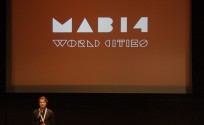Call for Papers
November 19 – 22, 2014 @ Aarhus, Denmark,
pre-conference event in Copenhagen
At the Media Architecture Biennale in 2014 we explore the emergence of new kinds of “World Cities” through media architecture. In this context, encounters may occur when media architecture is realized and people experience and interact with it, e.g. when public spaces and urban environments and the practices they shape are influenced by elements of media architecture; it may also occur as new platforms give rise to new opportunities for shaping systems and surroundings.
Important deadlines
Papers
Paper submission deadline: July 20 (extended)
Notification of acceptance: September 5
Camera-ready submission: September 25
Conference: November 19-22
Doctoral Consortium
Expression of interest: August 1
Submission deadline: August 30
Workshops
Expression of interest: April 27
Students Competition
Deadlines and more information will appear on mab14.mediaarchitecture.org shortly
Topics
We consider media architecture as an inclusive term that encompasses encounters and intersections between digital technologies and our physical surroundings. We invite papers that present and dis- cuss novel contributions to media architecture both on a practical and theoretical level and that further our understanding of the field through case studies, design approaches, and best practices. We expect contributions to critically explore a wide range of topics including, but not limited to:
• How to support the development of social structures with urban digital media
• Social & Cultural Aspects of Media Architecture
• Participatory Architecture & City Planning
• Spatial Locative Media
• Case Studies of Specific Projects
• Future Trends & Prototypes
• Media Facades & Urban Displays
• Interaction Techniques & Interfaces
• Critical & Historical Perspectives on Media Architecture
• Design Processes & Methods
Submission details
The conference invites research presentations from both academia and industry:
• We invite both short and long papers. Submitted papers should be a maximum of four and ten pages in length, for short and long papers respectively, in ACM format (see guidelines on acm.org).
• The papers should clearly explain the research question addressed, research methods and tasks, findings or results, and contributions of the work. Papers should also provide sufficient background and related work to situate and contextualize the authors’ work within the greater body of research.
• Submissions should consist of original work not previously published or concurrently under consideration for any other conference, workshop, journal, or other publication with an iSBN, iSSN or Doi number.
• Contribution statement on EasyChair: Authors must provide a 30-word contribution statement for their paper upon submission. The contribution should be added to the abstract in the ‘abstract field’ on the EasyChair submission system. The contribution statement should explain the contribution made by the paper to the Media Architecture community.
• Anonymous peer-review: Papers will be peer-reviewed by multiple members of a program committee consisting of experts in a range of disciplines that shape media architecture.
Our vision
Building on the successful event in Aarhus 2012, Media Architecture Biennale 2014 brings together artists, practitioners and researchers from academia and industry who work with media, interactive technologies and the built environment. The 2014 Biennale comprises an academic conference track, exhibitions, and industry sessions, as well workshops. Our vision is to provide an excellent forum for debate and knowledge exchange; to offer a unique opportunity that brings together the best minds and organizations; and to highlight state-of-the-art and experimental research in media architecture.
Theme: World Cities
Media architecture is an increasingly important digital layer in cities all over the world. It is a part of shopping malls, casinos, digital signs and commercials and it holds great potential as a mouthpiece for public voice and a peephole into the heart of government. The latter was exemplified when citizen reports and the municipality’s case handlings were visualized on Aarhus’ notable city hall tower during the Media Architecture Biennale 2012. It is also the case, when people in the streets of Berlin are invited to show their own animations using 144 lit-up windows in a central high-rise building, which happened in the iconic project Blinkenlights.
No matter if it is in Aarhus, Copenhagen or Berlin – or in Sao Paulo, Sydney or Beijing – media architecture augments public space and creates new settings for life in the city. These new settings will be the focus of the Media Architecture Biennale 2014.
The design of media architecture invites encounters between people, the built environment, and media space. It opens up rich opportunities for new forms of participation through dialogue and engagement. As an emerging field, diverse perspectives are coming together in media architecture, and the challenges are as abundant as the opportunities.
Host
Aarhus University, Denmark, in collaboration with Media Architecture Institute.
Information
Twitter: @MABiennale
Facebook: facebook.com/MABiennale
Web: mab14.mediaarchitecture.org
Email: conference@mediaarchitecture.org




































